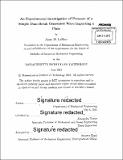An experimental investigation of pressure of a simple dam break generated wave impacting a plate
Author(s)
LaBine, Anne M
DownloadFull printable version (6.305Mb)
Other Contributors
Massachusetts Institute of Technology. Department of Mechanical Engineering.
Advisor
Alexandra Techet.
Terms of use
Metadata
Show full item recordAbstract
It is desirable to measure pressure of a wave striking a vertical surface because this information can be used to determine the strength needed in the building materials of marine structures that may be struck by tall waves. These waves may be caused by storms, tsunamis, or dam breaks and can cause serious damage. This thesis presents two experiments aimed at measuring the pressure exerted by a wave. In both experiments, a series of water waves are released from a reservoir. One wave is released at a time and the waves vary in the initial height of water in the reservoir. In the first experiment, pressure is calculated using a force sensor to determine the force on a paddle and a high-speed camera to determine the contact area. It was found that wave pressure increases as the initial height increases. The pressures ranged from 5+/-2kPa at 25+/-1cm initial water height and 12+/-2kPa at 45+/-1cm initial water height. In the second experiment, pressure is measured at multiple vertical and horizontal locations on a vertical cantilevered plate. A sensor located in the middle of the plate horizontally and 1.25in from the bottom recorded the highest maximum pressure for all trials. The pressures from this sensor for this experiment ranged from 1.6+/-0.1kPa at 20+/-1cm initial water height and 7.4+/-.4kPa at 45+/-1cm initial water height.
Description
Thesis: S.B., Massachusetts Institute of Technology, Department of Mechanical Engineering, 2015. Cataloged from PDF version of thesis. Includes bibliographical references (page 51).
Date issued
2015Department
Massachusetts Institute of Technology. Department of Mechanical EngineeringPublisher
Massachusetts Institute of Technology
Keywords
Mechanical Engineering.